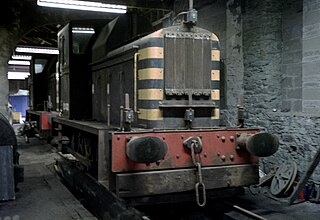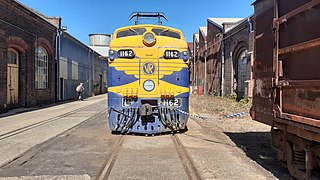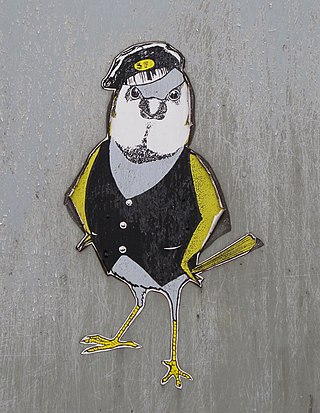
Sir Herbert Nigel Gresley was a British railway engineer. He was one of Britain's most famous steam locomotive engineers, who rose to become Chief Mechanical Engineer (CME) of the London and North Eastern Railway (LNER). He was the designer of some of the most famous steam locomotives in Britain, including the LNER Class A1 and LNER Class A4 4-6-2 Pacific engines. An A1 Pacific, Flying Scotsman, was the first steam locomotive officially recorded over 100 mph in passenger service, and an A4, number 4468 Mallard, still holds the record for being the fastest steam locomotive in the world (126 mph).

The British Rail Class 01 diesel locomotive is a short wheelbase 0-4-0 diesel-mechanical design intended for use in areas with tight curves and limited clearance.

The British Rail Class 02 are a class of twenty 0-4-0 diesel-hydraulic shunting locomotives built by the Yorkshire Engine Company in 1960 and 1961 (D2860-D2869) for service in areas of restricted loading gauge and curvature such as docks. They had the door to the cab at the rear, with a railed veranda behind the cab; this feature was very unusual on British Rail locomotives, although it was used on many Yorkshire Engine Co. designs and is quite normal in North American practice.

The British Rail Class 03 locomotive was, together with the similar Class 04, one of British Railways' most successful 0-6-0 diesel-mechanical shunters. 230 were built at Doncaster and Swindon works between 1957 and 1962, and were numbered D2000-D2199 and D2370-D2399. D2370 and D2371 were used as departmental locomotives and originally numbered 91 and 92 respectively.

The Duluth, Missabe and Iron Range Railway (DM&IR), informally known as the Missabe Road, was a railroad operating in northern Minnesota and Wisconsin that used to haul iron ore and later taconite to the Great Lakes ports of Duluth and Two Harbors, Minnesota. Control of the railway was acquired on May 10, 2004, by the Canadian National Railway (CN) when it purchased the assets of Great Lakes Transportation.

The British Rail Class 20, otherwise known as an English Electric Type 1, is a class of diesel-electric locomotive. In total, 228 locomotives in the class were built by English Electric between 1957 and 1968, the large number being in part because of the failure of other early designs in the same power range to provide reliable locomotives.

Brighton railway works was one of the earliest railway-owned locomotive repair works, founded in 1840 by the London and Brighton Railway in Brighton, England, and thus pre-dating the more famous railway works at Crewe, Doncaster and Swindon. The works grew steadily between 1841 and 1900 but efficient operation was always hampered by the restricted site, and there were several plans to close it and move the facility elsewhere. Nevertheless, between 1852 and 1957 more than 1200 steam locomotives as well as prototype diesel electric and electric locomotives were constructed there, before the eventual closure of the facility in 1962.
Locomotives of New Zealand is a complete list of all locomotive classes that operate or have operated in New Zealand's railway network. It does not include locomotives used on bush tramways.

Texas and Pacific 610 is a class "I-1a" 2-10-4 "Texas" type steam locomotive that was originally operated by the Texas and Pacific Railway (T&P). It served the T&P from 1927 to 1951 before being donated to the city of Fort Worth. It was briefly used for the American Freedom Train in the mid-1970s, and subsequently for the Southern Railway steam program. Since 1982, No. 610 has remained on static display at the Texas State Railroad's Hall of Giants in Palestine.

Immingham engine shed, also known as Immingham depot, or more recently as Immingham TMD and always locally as Loco is a railway maintenance depot located on the Immingham Dock estate, in North East Lincolnshire, England. The depot code is IM.

The Eisenbahnmuseum Bochum-Dahlhausen is a railway museum situated south of the city of Bochum in the state of North Rhine-Westphalia, Germany. It was founded by DGEG, the German Railway History Company in 1977 and is based in a locomotive depot that was built between 1916 and 1918 and ceased operation in 1969. Then DGEG took over the whole area of 46,000 square metres and built up the biggest railway museum in Germany. In the middle of the museum, there is an engine shed with fourteen tracks. A preserved turntable, coaling, watering, and sanding facilities are still in operation. This museum is integrated into The Industrial Heritage Trail a route of monuments from the history of the industry.

The Victorian Railways L class was a class of electric locomotives built by English Electric and operated by the Victorian Railways and later V/Line from 1953 until 1987 primarily on the Gippsland line. They were the only class of main line electric locomotive operated in Victoria.

Sir William Hepburn McAlpine, 6th Baronet, was a British businessman who was director of the construction company Sir Robert McAlpine.

The B class are a class of diesel locomotives built by Clyde Engineering, Granville for the Victorian Railways in 1952–1953. Ordered and operated by the Victorian Railways, they initiated the dieselisation of the system and saw use on both passenger and freight services, with many remaining in service today, both in preserved and revenue service. Some were rebuilt as the V/Line A class, while others have been scrapped.

Stratford TMD was a traction maintenance depot located in Stratford, London, England close to the Great Eastern Main Line. It was located just west of Stratford station, on a site now occupied by Stratford International station. The depot was at one time the biggest on the London and North Eastern Railway with locomotives covering duties from express services to freight workings in London's docks.

Clyde Engineering was an Australian manufacturer of locomotives, rolling stock, and other industrial products.

The Georgia State Railroad Museum is a museum in Savannah, Georgia located at a historic Central of Georgia Railway site. It includes parts of the Central of Georgia Railway: Savannah Shops and Terminal Facilities National Historic Landmark District. The complex is considered the most complete antebellum railroad complex in the United States. The museum, located at 655 Louisville Road, is part of a historic district included in the National Register of Historic Places.

Ipswich engine shed was an engine shed located in Ipswich, Suffolk on the Great Eastern Main Line. It was located just south of Stoke tunnel and the current Ipswich railway station. Locomotives accessed the site from Halifax Junction which was also the junction for the Griffin Wharf branch of Ipswich docks. The depot opened in 1846 and closed in 1968 although the site remained in railway use for a further thirty years.

The South African Railways Class 4E of 1952 was an electric locomotive.

Coldham Lane Depot is a traction maintenance depot located in Cambridge, Cambridgeshire, England. The depot is situated on the eastern side of the Fen Line and is to the north of Cambridge Station.




















